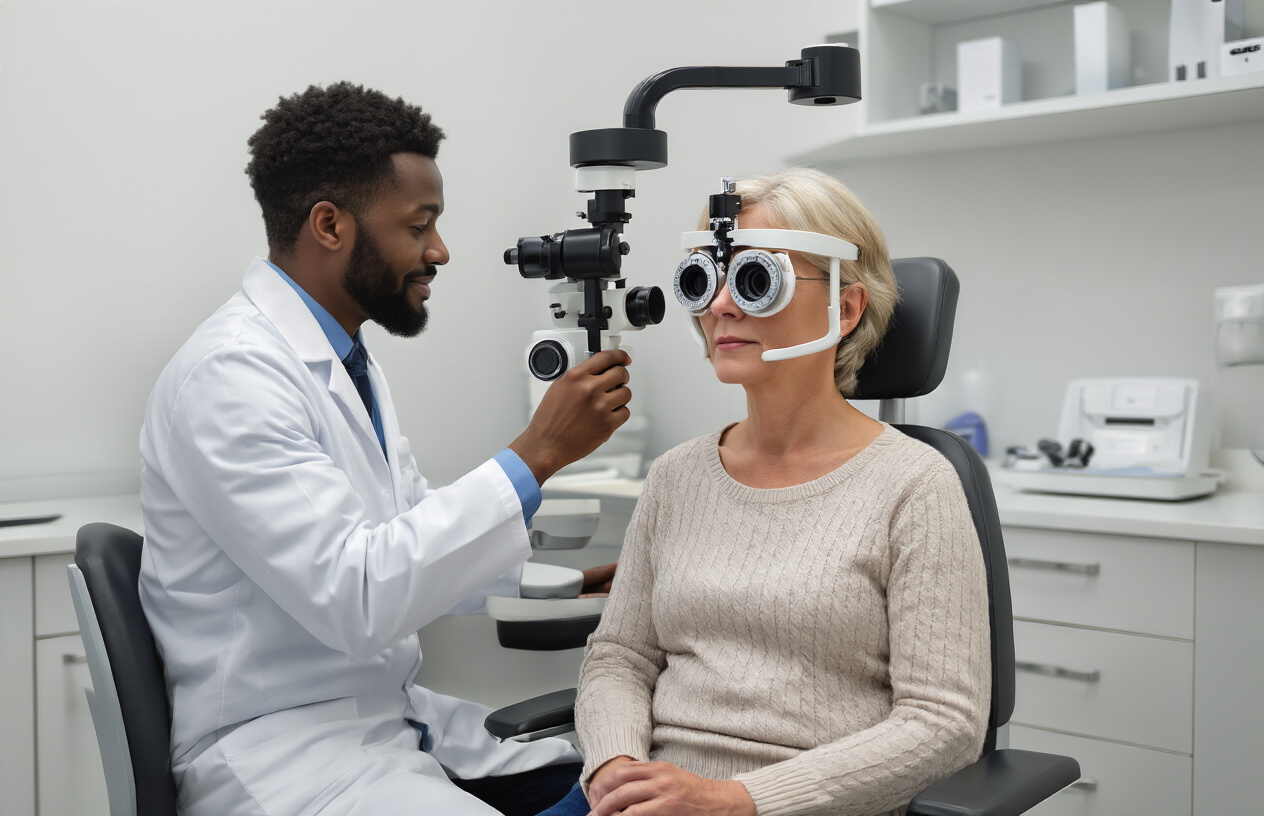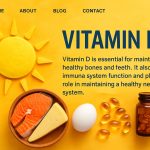Your eyes work hard every day, and taking care of them now can help you maintain sharp vision for years to come. These eye care tips are perfect for anyone who wants to protect their sight – whether you’re dealing with daily screen time, planning for the future, or simply want to keep your eyes healthy.
Most vision problems can be prevented with simple daily habits and smart lifestyle choices. We’ll cover how to shield your eyes from everyday hazards at home, work, and play, plus show you which foods and nutrients give your eyes the best support. You’ll also learn why regular eye exams matter so much – they can catch problems early and even spot signs of other health conditions before symptoms appear.
Small changes in how you protect and nourish your eyes today can make a huge difference in keeping your vision crystal clear tomorrow.
Protect Your Eyes in Daily Environments

Safeguard Vision at Home During Cooking and Cleaning
Kitchen environments pose numerous risks to eye health that many homeowners overlook. When cooking, hot oil splatter represents one of the most significant hazards, capable of causing severe burns to the delicate eye tissues. Always maintain a safe distance from frying pans and use splatter screens to create a protective barrier. Steam from boiling pots can also cause thermal injuries, so position yourself to avoid direct steam exposure when removing lids.
Chemical exposure during cleaning activities requires particular attention. Many household cleaners contain harsh ingredients that can cause chemical burns or irritation upon contact with eyes. When using ammonia-based products, bleach, or oven cleaners, ensure adequate ventilation and consider wearing protective eyewear. Store cleaning products safely away from areas where accidental splashing might occur.
Proper lighting throughout your home prevents eye strain and reduces accident risks. Install adequate task lighting in work areas, particularly in kitchens where knife work requires precise vision. Replace burnt-out bulbs promptly and consider LED options that provide consistent, eye-friendly illumination.
Prevent Workplace Eye Injuries and Computer Strain
Digital eye strain has become increasingly prevalent as screen time dominates modern work environments. The 20-20-20 rule provides essential relief: every 20 minutes, look at something 20 feet away for at least 20 seconds. This simple practice helps relax focusing muscles and reduces accommodation fatigue.
Proper workstation ergonomics significantly impacts eye comfort. Position your monitor 20-26 inches from your eyes, with the top of the screen at or slightly below eye level. Adjust brightness to match your surrounding environment, avoiding screens that are either too bright or too dim compared to ambient lighting.
Industrial and construction workers face unique eye hazards requiring specialized protection. Flying debris, chemical splashes, and intense light exposure demand appropriate safety eyewear certified for specific workplace conditions. Regular inspection and replacement of protective equipment ensures continued effectiveness against occupational eye injuries.
Stay Safe During Celebrations and Fireworks Events
Fireworks-related eye injuries spike dramatically during holiday celebrations, with many resulting in permanent vision loss. Maintain a safe distance of at least 500 feet from professional fireworks displays and never attempt to relight malfunctioning fireworks. Consumer fireworks, while seemingly safer, still pose significant risks and require adult supervision and proper handling techniques.
Party environments often involve decorative elements that can endanger vision. Confetti cannons, sparklers, and champagne corks create projectile hazards that can cause serious eye trauma. When participating in celebrations, remain alert to potential flying objects and position yourself away from direct firing paths of party favors.
Maintain Eye Health Through Lifestyle Choices

Wear Proper Protection During Sports Activities
Athletic activities pose significant risks to eye health, making protective eyewear essential for maintaining optimal vision. Sports-related eye injuries can range from minor irritations to severe trauma that may result in permanent vision loss. Whether participating in contact sports like basketball and soccer or racquet sports such as tennis and squash, appropriate eye protection should be considered mandatory equipment.
Safety glasses specifically designed for sports activities offer superior protection compared to regular prescription glasses or sunglasses. These specialized protective eyewear options feature impact-resistant lenses and secure wraparound frames that stay in place during intense physical activity. For swimmers, goggles prevent chlorine exposure and waterborne irritants that can cause eye inflammation and discomfort.
Shield Eyes from Sun Damage and Allergens Outdoors
Now that we have covered sports protection, outdoor environmental factors present another critical consideration for eye health maintenance. Ultraviolet radiation from sun exposure can cause both immediate and long-term damage to the delicate structures of the eyes, including the cornea, lens, and retina.
Quality sunglasses with 100% UV protection are essential whenever spending time outdoors, regardless of weather conditions. UV rays remain present even on cloudy days and can reflect off surfaces like water, snow, and pavement, intensifying exposure. Wide-brimmed hats provide additional protection by reducing the amount of UV radiation reaching the eye area from above and the sides.
Seasonal allergens such as pollen, dust, and other airborne particles can trigger allergic reactions that cause itching, redness, and excessive tearing. Wraparound sunglasses help create a barrier against these irritants while spending time outdoors during peak allergy seasons.
Pack Essential Eye Care Items When Traveling
With this in mind, next, we’ll examine the importance of maintaining eye care routines while traveling. Changes in climate, air quality, and daily schedules can significantly impact eye comfort and health during trips. Dry cabin air during flights often causes eye irritation and discomfort, making artificial tears or lubricating eye drops essential travel companions.
Different geographic locations may expose travelers to unfamiliar allergens or environmental conditions that affect eye health. Packing a comprehensive eye care kit ensures preparedness for various situations that may arise. Essential items include preservative-free artificial tears, sunglasses with UV protection, daily contact lens supplies if applicable, and any prescription eye medications.
Quit Smoking to Prevent Eye Disease
Previously, we’ve discussed external protective measures, but internal health factors play an equally crucial role in maintaining eye health. Smoking creates significant risks for multiple serious eye conditions that can lead to vision impairment or blindness. The harmful chemicals in tobacco smoke damage blood vessels throughout the body, including the delicate vessels that supply the eyes with essential nutrients and oxygen.
Research consistently demonstrates strong connections between smoking and increased risks of age-related macular degeneration, cataracts, and diabetic retinopathy. Smokers face double the risk of developing cataracts compared to non-smokers, and the likelihood increases with the duration and intensity of smoking habits. The toxic substances in cigarette smoke also contribute to dry eye syndrome by reducing tear production and affecting tear quality.
Quitting smoking provides immediate and long-term benefits for eye health, with improvements in circulation and reduced inflammation occurring within weeks of cessation.
Nourish Your Eyes Through Diet and Beauty Practices

Eat Eye-Healthy Foods Rich in Vitamins and Nutrients
Previously, we’ve discussed environmental protection and lifestyle adjustments for optimal eye health. Now that we have covered those foundational elements, proper nutrition emerges as another critical pillar for maintaining perfect vision throughout your lifetime.
A well-balanced diet rich in specific vitamins and minerals can significantly impact your eye health. Focus on incorporating foods high in vitamin A, which supports retinal function and night vision. Carrots, sweet potatoes, and leafy green vegetables like spinach and kale provide abundant beta-carotene, which your body converts to vitamin A.
Omega-3 fatty acids play a crucial role in maintaining the structural integrity of eye tissues. Include fish such as salmon, mackerel, and sardines in your weekly meal planning. For plant-based alternatives, walnuts, flaxseeds, and chia seeds offer excellent omega-3 content.
Antioxidants like lutein and zeaxanthin act as natural filters against harmful blue light and protect against age-related macular degeneration. These compounds concentrate naturally in egg yolks, corn, and colorful vegetables including bell peppers and broccoli.
Vitamin C and E work synergistically to combat oxidative stress in eye tissues. Citrus fruits, berries, and nuts provide these essential nutrients that support overall ocular health and may help prevent cataracts.
Apply Makeup Safely to Avoid Eye Infections
With this in mind, next we’ll explore how cosmetic practices can either support or compromise your eye health goals. Proper makeup application and hygiene practices are essential for preventing irritation and infections around the delicate eye area.
Always remove makeup thoroughly before sleeping, as leftover products can clog oil glands and lead to styes or other complications. Use gentle, oil-free makeup removers specifically designed for the eye area to avoid harsh rubbing that could damage sensitive skin.
Replace eye makeup products regularly – mascara should be discarded every three months, while eyeshadows and eyeliners can last up to two years when stored properly. Never share eye makeup with others, as this increases the risk of bacterial transmission.
When applying makeup, avoid placing products directly on the waterline or too close to the eye’s surface. This practice can introduce bacteria into tear ducts and cause irritation or infection.
Choose hypoallergenic and fragrance-free products when possible, especially if you have sensitive eyes or wear contact lenses. Test new products on a small skin area before full application to identify potential allergic reactions.
Follow Proper Contact Lens Hygiene Rules
Now that we have covered nutritional and cosmetic considerations, contact lens hygiene represents another critical aspect of comprehensive eye care that requires consistent attention to detail.
Wash and dry your hands thoroughly before handling contact lenses to prevent transferring bacteria or debris to your eyes. Use only recommended cleaning solutions – never use tap water, saliva, or homemade solutions that could introduce harmful microorganisms.
Replace your contact lenses according to the prescribed schedule, whether daily, weekly, or monthly. Overwearing lenses increases protein buildup and reduces oxygen transmission to your corneas, potentially leading to complications.
Clean and replace your contact lens case every three months, and never reuse old cleaning solution. Fill the case with fresh solution each time you store your lenses.
Remove contact lenses immediately if you experience redness, pain, or unusual discharge. Swimming or showering while wearing contacts can expose your eyes to waterborne pathogens that cause serious infections.
Follow the recommended wearing schedule provided by your eye care professional, and never sleep in contacts unless they’re specifically designed for extended wear.
Address Eye Care Needs at Different Life Stages

Monitor Vision Changes During Pregnancy
Now that we have covered environmental protection and lifestyle choices, let’s explore how life stages affect eye care needs. Pregnancy brings significant physiological changes that can impact vision and eye health. Hormonal fluctuations during pregnancy can cause temporary vision changes that typically resolve after delivery.
Common pregnancy-related vision changes include:
- Dry eyes due to decreased tear production
- Slight changes in prescription needs
- Increased sensitivity to light
- Temporary blurred vision from fluid retention
Pregnant women should continue regular eye exams and inform their eye care provider about their pregnancy status, as certain treatments and medications may need adjustment.
Protect Children’s Developing Eyes from Screen Time
With this foundation established, children’s eye care requires special attention during their developmental years. Young eyes are particularly vulnerable to digital eye strain as screen usage increases in educational and recreational settings.
Key protective measures include:
- Implementing the 20-20-20 rule: every 20 minutes, look at something 20 feet away for 20 seconds
- Ensuring proper lighting when using devices
- Maintaining appropriate screen distance
- Limiting recreational screen time according to age guidelines
- Scheduling regular pediatric eye exams to detect early vision problems
Parents should watch for signs of vision issues such as squinting, eye rubbing, or complaints of headaches after screen use.
Establish Healthy Eye Habits in College Years
Previously, we’ve seen how early intervention matters. College years present unique eye care challenges as students face increased academic demands, irregular sleep patterns, and extended computer use for studies and social activities.
Essential habits for college students include:
- Maintaining consistent sleep schedules to prevent eye fatigue
- Using proper lighting while studying
- Taking regular breaks from close-up work
- Staying hydrated to support tear production
- Avoiding eye rubbing, especially in shared living environments
This life stage often marks the beginning of more independent healthcare decisions, making it crucial to establish lasting eye care routines.
Schedule Regular Eye Exams Starting at Age 40
With this understanding of earlier life stages, adults approaching middle age face new eye care considerations. Age 40 marks a critical transition period when presbyopia typically begins, and the risk for age-related eye conditions increases significantly.
Recommended screening schedule includes:
- Comprehensive eye exams every 1-2 years after age 40
- Annual exams for those with risk factors
- Monitoring for early signs of glaucoma, cataracts, and macular degeneration
- Blood pressure and diabetes screening, as these conditions affect eye health
Early detection through regular screenings enables timely intervention and helps preserve vision throughout the aging process.
Recognize and Treat Common Eye Conditions

Identify Migraine-Related Vision Changes
With the lifestyle choices covered previously, it’s important to recognize how certain medical conditions can impact your vision. Migraines often present with distinctive visual symptoms that can serve as warning signs of an impending episode. These visual disturbances, known as migraine auras, typically occur 10 to 30 minutes before the headache phase begins.
Common visual symptoms associated with migraines include:
- Scintillating scotomas: Shimmering or flickering blind spots that may appear as zigzag patterns
- Photophobia: Increased sensitivity to light that can worsen during an episode
- Tunnel vision: Temporary narrowing of the visual field
- Temporary vision loss: Brief periods where vision becomes blurred or completely obscured
- Visual distortions: Objects may appear wavy or fragmented
Understanding these patterns helps differentiate migraine-related vision changes from other serious eye conditions. If you experience sudden, severe visual changes without a history of migraines, seek immediate medical attention.
Handle Contagious Eye Infections Properly
Now that we’ve covered migraine symptoms, let’s address another critical aspect of eye health: managing contagious infections. Proper handling of infectious eye conditions protects both your vision and prevents transmission to others.
Key prevention and management strategies include:
- Practice strict hand hygiene: Wash hands thoroughly before and after touching the eye area
- Avoid sharing personal items: Never share towels, pillowcases, or eye makeup
- Replace contaminated products: Discard eye makeup and contact lenses used during infection
- Follow isolation protocols: Stay home when symptoms are active to prevent workplace transmission
Understand How STDs Can Affect Eye Health
Previously, we’ve discussed common infections, but it’s crucial to understand that sexually transmitted diseases can also impact ocular health. Several STDs can cause serious eye complications if left untreated, making awareness and prevention essential components of comprehensive eye care.
STD-related eye conditions require immediate medical intervention to prevent permanent vision damage. Regular testing and safe practices remain the most effective prevention methods for protecting both reproductive and ocular health.
Schedule Regular Eye Screenings for Early Detection

Catch Symptomless Eye Diseases Like Glaucoma Early
With the foundation of daily eye protection and healthy lifestyle choices established, the next critical step in maintaining perfect vision is proactive monitoring through regular eye examinations. Many serious eye conditions develop silently, without obvious symptoms, making routine screenings your most powerful defense against vision loss.
Glaucoma, often called the “silent thief of sight,” exemplifies why regular eye exams are non-negotiable for optimal eye health. This group of eye diseases gradually damages the optic nerve, typically without causing pain or noticeable vision changes until significant damage has occurred. By the time patients notice vision problems, irreversible damage may have already taken place.
Early detection through comprehensive eye exams allows eye care professionals to identify elevated intraocular pressure, optic nerve changes, and visual field defects before they progress to advanced stages. When caught early, various treatment options including eye drops, laser procedures, and surgical interventions can effectively slow or halt disease progression, preserving your vision for years to come.
The frequency of eye screenings should align with your risk factors and age. Adults over 40, individuals with family histories of glaucoma, and those with certain medical conditions require more frequent monitoring. Even young adults with no symptoms benefit from baseline examinations to establish healthy benchmarks for future comparisons.
Detect Underlying Health Conditions Through Eye Exams
Previously, I’ve discussed how lifestyle choices impact eye health, but comprehensive eye examinations serve another crucial purpose beyond detecting eye-specific conditions. Your eyes function as windows to your overall health, often revealing systemic diseases before symptoms appear elsewhere in your body.
During dilated eye examinations, eye care professionals can identify signs of diabetes, hypertension, autoimmune disorders, and neurological conditions. Diabetic retinopathy, for instance, may be the first indication of diabetes progression, while changes in retinal blood vessels can signal cardiovascular problems. These early warnings enable prompt medical intervention, potentially preventing serious health complications.
The retina’s unique structure allows direct visualization of blood vessels, nerves, and tissues without invasive procedures. This non-invasive window into your circulatory and nervous systems makes eye exams invaluable screening tools for systemic health monitoring.
Regular eye screenings also help track medication side effects, monitor chronic conditions, and assess how well treatments are working. Many medications can affect vision or eye health, making ongoing professional monitoring essential for patients taking certain prescriptions.
With this comprehensive approach to eye care in mind, scheduling annual eye exams becomes an investment in both vision preservation and overall health maintenance, ensuring early intervention when it matters most.

Protecting your vision requires a comprehensive approach that encompasses every aspect of your daily life. From wearing protective eyewear in hazardous environments and maintaining proper screen distance to nourishing your eyes with dark leafy greens and orange vegetables, small consistent actions make a significant difference. Whether you’re navigating the unique eye care needs of childhood, pregnancy, or your golden years, adapting your habits to each life stage ensures optimal eye health throughout your lifetime.
The most powerful tool in preserving perfect vision is regular eye screening by an ophthalmologist. Many serious eye diseases like glaucoma progress silently without symptoms, making early detection crucial for preventing vision loss. By age 40, establish a baseline eye exam, and remember that these screenings can also reveal underlying health conditions like diabetes and arthritis. Take proactive steps today to protect your sight – your future self will thank you for the gift of clear, healthy vision.













